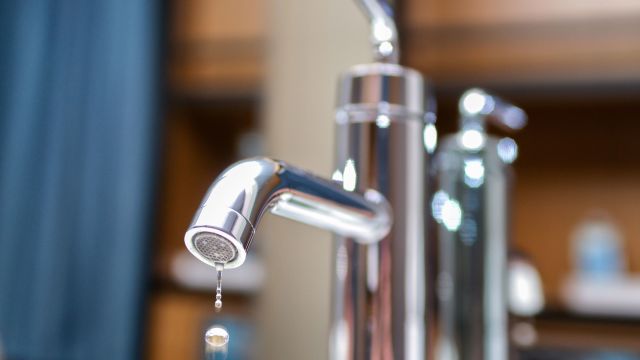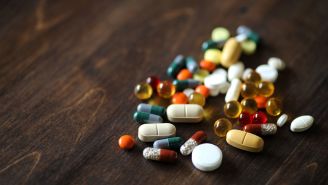Your home is supposed to be a safe haven for you and your family, but this hidden danger could be lurking in your pipes. Lead is a heavy metal that occurs naturally in the earth and can pose some serious risks to the health of humans and animals.
In 2015, water supplied to 3.9 million Americans—in 1,110 different communities—exceeded the Environmental Protection Agency’s (EPA) actionable limit for lead, according to the Natural Resources Defense Council. The EPA has set limits for the amount of lead permitted in your water, and these levels cannot surpass 15 parts per billion (ppb) in tap water or five ppb in bottled water.
"With good water safety practices, we think we can meet the fifteen part per billion standard, but that doesn't mean it's safe," says Mary Jean Brown, RN, a doctor of science, adjunct faculty member with Harvard Chan School of Public Health and former Chief of the Healthy Homes and Lead Poisoning Prevention Branch at the Centers for Disease Control and Prevention.
Here's what you need to know about lead exposure, including how contamination happens, the harmful effects of this heavy metal and what you can do to protect your family.
How lead exposure really happens
When lead pipes corrode or break down, the metal can enter your water and trickle right into your drinking glass. There are a number of factors that determine just how much lead gets into the water.
- Acidity and mineral composition of the water
- Water temperature
- How long water sits in the pipes
- Amount of deterioration
Drinking water can contribute to 20 percent or more of a person's exposure to lead, according to the EPA, but lead can also lurk in other places, like soil and paint. When lead paint deteriorates or contaminated soil is kicked into the air, it can be breathed right into your body. Soil naturally contains lead, but industrial activities like mining and smelting, the process of extracting metal using heat, can increase the amount of lead in the soil of a particular area.
"It doesn't matter where you get the lead, the dangers are the same," Brown says. "It doesn't matter if it's in the water or in the dust."
Regardless of how lead enters your body, exposure is harmful, especially for the health of children. And experts agree, there is no safe level of the substance in your body.
The damaging effects of this heavy metal
No one is immune to the harmful effects of lead, but certain groups, like children and pregnant women, are at a higher risk for complications.
Children under the age of 6 with elevated levels of lead in their bloodstream, a measure of 5 micrograms per deciliter or above, are at an increased risk for short- and long-term effects. Exposure can result in headaches or stomach pain in the short term and lead to developmental delays, kidney and nerve damage, speech problems as well as poor muscle strength and coordination.
"Children who have too much lead in their blood are more likely to lose a few IQ points and have behavioral problems that have a bad impact on their academic performance and their later life success," Brown says.
If pregnant women are exposed to lead, their unborn babies may be at an increased risk of related complications. "Lead easily crosses into the brain of fetuses, infants and small children," Brown says. Lead exposure during pregnancy increases the risk of miscarriage and premature birth and can harm the development of the child's brain, kidneys and nervous system.
"As you get older, lead is less likely to cross into your brain," Brown says. "The effects of lead in water on adults would be subtle."
The severity of symptoms is determined by the length and degree of exposure. Lead exposure in adults can lead to an increased risk of:
- Hypertension
- Anemia
- Hearing loss
- Irritability
- Seizures
- Nausea
- Constipation
- Difficulty concentrating
Overtime, if lead builds up in the body—even at low levels—it can increase your risk of cancer- and heart-related death and all-cause mortality. Testing your water for contamination can help you become more aware of exposure, so you can take action to stop it.
How to test your water at home
Lead is odorless, colorless and tasteless, so you won't notice you're drinking tainted water. "You should be able to call your water supplier and they should be able to tell you what the lead levels are," Brown says. All community water suppliers in the US are required by the EPA to create an annual water quality report, which should be sent to your home. Reports may also be available online, or you can call your provider for a copy.
If your water is not provided by a public supplier or comes from a private well, you must have it tested yourself for lead and other common contaminants, like bleach, bacteria and parasites. At-home test kits can also be purchased for less than $100 and analyzed at a certified lab in your area. To get the best results, follow the kit directions closely and be diligent in selecting a facility that specializes in this kind of testing. You can find a certified lab by vising the EPA website or calling the Safe Drinking Water Hotline at 800-426-4791. Before collecting your at-home water sample, Brown recommends allowing water to sit in the pipes for about eight hours, without turning on sinks, flushing toilets or using the dish washer or washing machine. After the eight-hour wait period, take the first sample of water that comes from the faucet. There isn't protocol for how often to test your home's water, but if you have lead pipes or suspect corrosion, having it tested annually may be a good idea.
If your water tests positive for lead the EPA recommends flushing the pipes—by running the water until it gets cold—anytime the water has been sitting for six hours or more or replacing pipes and plumbing fixtures that contain lead.
What you can do about lead in your water
If tests reveal unsafe levels of lead in your water, there are some steps you can take to protect yourself and your family from exposure.
"If people are concerned about lead in their water, and decide they want to get a water filter, they have to get one that's approved by the National Sanitation Foundation," Brown says. If you opt for a water filter, follow the directions carefully and be sure to change the filter as needed.
Other tips for reducing exposure to lead from drinking water include:
- Using cold water, expect for showering or washing laundry
- Running water before using for drinking or cooking
- Cleaning the screen on your faucet
Unfortunately, lead isn't going anywhere, but becoming aware of the potential dangers can help you avoid subjection to its harmful effects.
Medically reviewed in March 2018.






